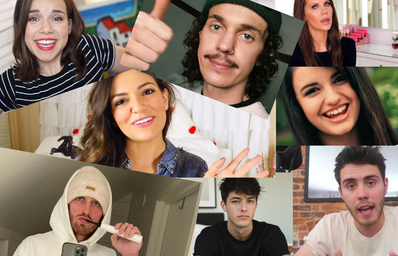Did anyone else have “the downfall of mainstream YouTube” on their 2022 bingo card? The 2010s felt like a golden age for the video streaming platform, with creators like Zoella and Jenna Marbles taking the internet by storm. YouTube gave anyone and everyone a platform, allowing creators to produce content completely unique to anywhere else on the web, and was originally designed for anyone to be able to post anything they wanted. The platform paved the way for new content styles, like unboxing, shopping hauls, and morning routine videos (among others).
Between algorithm changes, the rise of capitalism, and the creation of new streaming platforms, there’s a lot to tackle when it comes to YouTube’s downfall. Since the early 2010s, YouTube has been one of Gen Z’s favorite pastimes, but many of the top creators have since shut down their channels or moved to different ones. Now, TikTok is Gen Z’s video streaming platform of choice. So, where did it all go wrong?
Creators thrived during YouTube’s early days, but for some, the platform has become overwhelming.
YouTube was launched on February 14, 2005, and its most iconic, meme-inspiring videos were uploaded during the early years, like “Charlie Bit My Finger,” “Friday,” and “Charlie the Unicorn.” Rebecca Black, the talent behind the masterpiece that is “Friday,” was one of the most Googled names of 2011, and the singer made her music comeback in 2021 with a remix of the track. “Charlie the Unicorn” was ranked on TIME’s “YouTube’s 50 Best Videos” in 2010, and has even carried over to TikTok (one viewer commented “This was my childhood”). Even some of today’s most popular musicians got their start on YouTube, including Shawn Mendes, Alessia Cara, and The Weeknd.
Although YouTube once supported successful creators, it appears the platform has since turned its back on them. Numerous creators have spoken out about how they feel unsupported by YouTube — specifically, that the platform has negatively impacted their mental health and sense of work-life balance.
According to Felix Kjellberg (AKA PewDiePie), YouTube doesn’t appear to cultivate a space where it feels safe to take a “vacation” from posting. Instead, the platform has inherently created an audience that expects a constant stream of content — and if creators slow down, their channels pay the price. Additionally, in 2020, the platform made the decision to include advertisements in all videos, meaning that small creators who attract viewers by having ad-free videos (thus growing their channels) no longer have that option.
YouTubers have also noted that the site doesn’t keep them in the loop when it comes to major decisions that directly impact them. YouTube’s announcement that all videos would include advertisements blindsided and upset small creators, who get no cut of the revenue. They’re at the mercy of the big platforms.
As platforms like TikTok and Twitch grow in popularity, more creators are beginning to believe that Livestreams are a superior way to generate income. Additionally, Patreon, a crowdfunding website where creators can earn revenue on what they make, has been widely used by YouTubers (the platform allows them to still create videos while having a continuous stream of income). For example, YouTuber Kurtis Conner has a Patreon where his followers can become “patrons” for a flat rate per month and access content like extra videos and presale codes for tours. Since many creators’ YouTube earnings are plummeting, options like Patreon can help them sustain an income.
In 2011, YouTube began neglecting its creators.
Soon after YouTube’s original, creator-centered tagline “Broadcast yourself” was dropped from the brand in 2011, the site began to move in a different, less creator-centric direction. Many beloved YouTubers (Joey Graceffa, Tyler Oakley, Alfie Deyes, and Ingrid Nilsen) have left the platform over the years, citing a variety of reasons for the exit. According to Business Insider, YouTube changed its algorithm multiple times, began cracking down on permitted content, and introduced YouTube Premium (previously known as YouTube Red). Creators also cited how the general lack of communication from the company left creators feeling angry, forgotten, and confused, and seeing negative impacts on their mental health.
Perhaps the most prominent example of YouTube’s turn from a creator-centered platform was the implementation of their annual “Brandcast” event, starting in 2011, where upcoming YouTube Originals content and new ad offerings were revealed (it’s giving very much big business and capitalism).
Besides the systemic flaw that YouTube perpetuates burnout culture, YouTube’s algorithm is a numbers game. When creators work hard to create videos that later don’t perform well — in some ways, because of the algorithm — the experience can have a negative impact on YouTubers’ mental health. The site leaves no room for taking breaks, expecting consistency in upload schedules instead. On top of that, we simply weren’t meant to interact with thousands of people every day, and creators can become easily affected by the number of people giving them feedback on their work.
When Vine creators transitioned to YouTube, things became problematic…fast.
In 2017, the Vine app — which involved looping six-second videos — was shut down. Following the closure, an influx of Viners rushed to YouTube (think Liza Koshy, Danny Gonzalez, and the Paul brothers). This led to disdain from the platform’s original creators who were still on the platform and had built up their followings over time.
On the other hand, Viners had preexisting fanbases and ultimately contributed to the demonetization of countless videos and a significant crackdown on what could be uploaded (thanks in part to Logan Paul’s awful video from the Aokigahara forest in Japan in which he filmed the body of a man who had died by suicide). Popular creator PewDiePie also played a role in the demonetization and restrictions when he posted a reaction video that included an anti-Semitic comment, as did an influx of terrorist recruitment videos. Advertisers fled YouTube as a result. Even so, YouTubers like Logan Paul still have large social media followings despite their problematic behaviors.
It wasn’t until 2020 that YouTubers started being called out for their unacceptable behavior. Shane Dawson and Jeffree Star, for example, were held accountable for their racist behavior and inappropriate comments about children, and racist, derogatory, and threatening comments, respectively, while drama between YouTubers spread like wildfire, like Star vs. Mason Disick’s fight, in which the then-10-year-old son of Kourtney Kardashian and Scott Disick called Star “spoiled af” during a Livestream and Tati Westbrook vs. James Charles’s fight after Westbrook publicly denounced Charles (her former mentee and friend) for various things, including Charles’ promotion of SugarBearHair instead of Westbrook’s own hair vitamin company.
Could the “commentary” video genre save YouTube?
The callouts and creator wars led to the rise of a new type of account: “commentary” YouTubers — like Cody Ko, Kurtis Conner, and Danny Gonzalez, to name a few — who report on the drama in a way that is both informative and entertaining. Commentary videos, in which the creator expresses their opinions on certain topics, became the platform’s new golden goose – as of November 15, 2021, the genre is one of the most well-liked on the platform.
For example, D’Angelo Wallace quickly rose in popularity with in-depth analysis videos exposing not only the surface level gossip, but also its underlying societal implications. This video type was a hit, with Wallace jumping from 600,000 subscribers to over 1 million in the span of a week during July of 2020.
Commentary YouTube seems to be the sole surviving genre for Gen Z, perhaps because it matches our humor (even though a majority of commentary YouTubers are nearly-30-year-old-men). Much like early YouTube, there’s an emphasis on comedy, but it’s presented in a different way than that of a decade ago. Instead of animations and parody songs, funny people make fun of bad content, and we all know the internet loves to hate: Creators make jokes about TikTokers and YouTube’s stringent guidelines, but they also raise money for causes that are important to Gen Z, like environmental cleanups. Their humor lives on outside of YouTube, and they use their other platforms to interact with fans and each other, keeping their audience engaged and promoting new content.
Although YouTube lives on, TikTok is taking over.
Another reason for decreased interest in YouTube could be thanks to TikTok itself. While TikTok was launched years ago in 2016, it experienced most of its growth during the beginning of the COVID-19 pandemic. The app, which reached 1 billion users globally as of September 2021 and has been downloaded a total of 2.6 billion times, features videos ranging from a few seconds to three minutes long. TikTok speaks to Gen Z’s short attention span and overall preference for short-form content.
“Most of Gen Z prefers TikTok videos over lengthy YouTube vlogs because they have an attention span of just eight seconds, which is a few seconds shorter than millennials, who have an attention span of around 12 seconds,” psychologist Elizabeth Lombardo, PhD tells Her Campus. After all, imagine that you’re Googling a tutorial for something (e.g. how to channel that Y/N energy at Harry Styles’s concert so he instantly falls in love with you). Would you rather watch a 30-minute video or a 30-second one?
Ashley, a blogger, agrees. “One of the most important factors of YouTube is that the content it pushes is long-form…essentially 15-minute-and-up type of content,” she says. “Unfortunately, with this day and age, much of the Gen Z population prefers short form and quick content. This doesn’t mean YouTube is dying out, just that it pushes to a different type of audience.”
To be fair, it seems that YouTube has noticed this trend. Take Gen Z favorite Cody Ko for example; 83% of his 12 most recent uploads on YouTube were shorter than 20 minutes. Just four years ago, Zoella was uploading videos verging on 30 minutes long. Multiple popular creators started accounts on TikTok (albeit, some reluctantly) back in 2019, in an effort to adapt to the times.
What about those famed content houses?
Another remnant of YouTube that has largely died out is content houses — AKA physical spaces for groups of creators and influencers to collaborate — that first originated because of YouTube. In 2014, the YouTube channel Our Second Life moved into the O2L Mansion, and 2015 saw most of the top Viners move into an apartment complex known as 1600 Vine Street. One of the most well-known YouTube content houses was the Team 10 House, purchased by Jake Paul in 2017 for his group of collaborators (known as Team 10) to share. The O2L Mansion broke up following Connor Franta’s exit in 2014, and Paul sold the Team 10 mansion in 2020 because he wanted to focus on his new profession as a boxer.
TikTok’s Hype House was formed in 2019 by YouTube star Thomas Petrou and TikToker Lil Huddy and has even recently gotten its own reality show. It used to house stars like the D’Amelio sisters (Charli and Dixie) and Addison Rae, but they’ve since moved on, and the Hype House has been struggling financially. 2020 also saw the creation of another TikTok content house, the Sway House, which split up a year later, with member Griffin Johnson stating that they had decided they were “over it.” It looks like content houses are dying, too, after all.
So, is the YouTube era dead?
It’s safe to say that YouTube isn’t dead — it’s just changed career paths. Instead of shopping hauls (fast fashion is so not it), we’re watching reviews of poorly animated movies. In general, consumers love content that either a) won’t take hours to consume or b) that will actually make us laugh. If YouTube won’t support original and creative content, then we’ll look for it elsewhere. Gone are the days of Bethany Mota’s morning routines — we’re on social media for the quick humor, not the capitalism.


